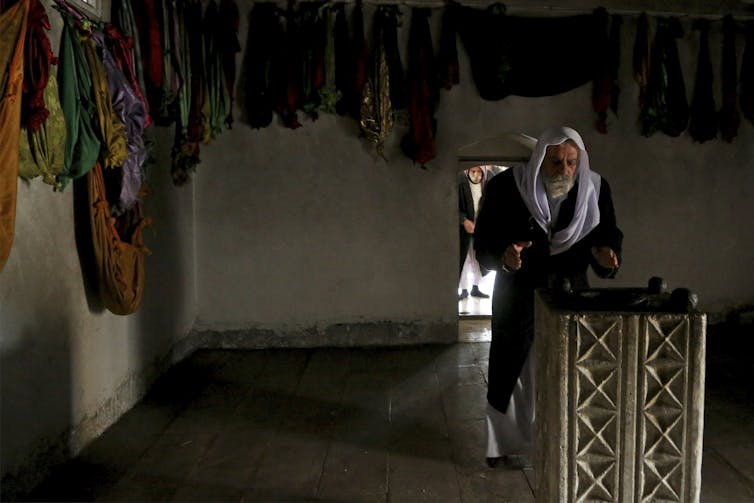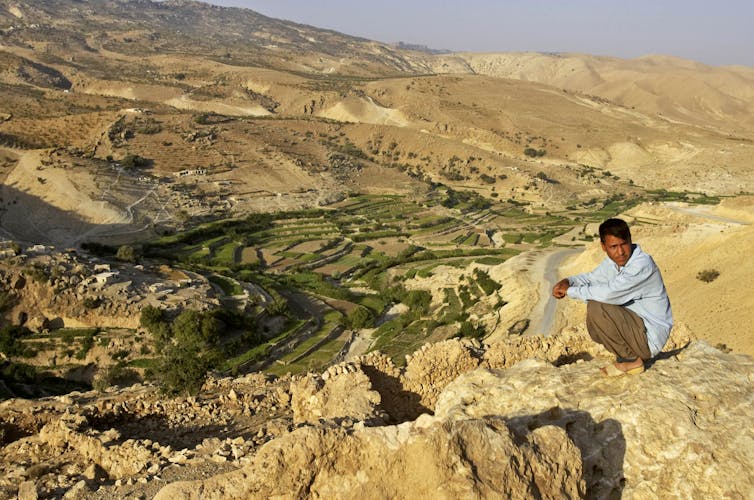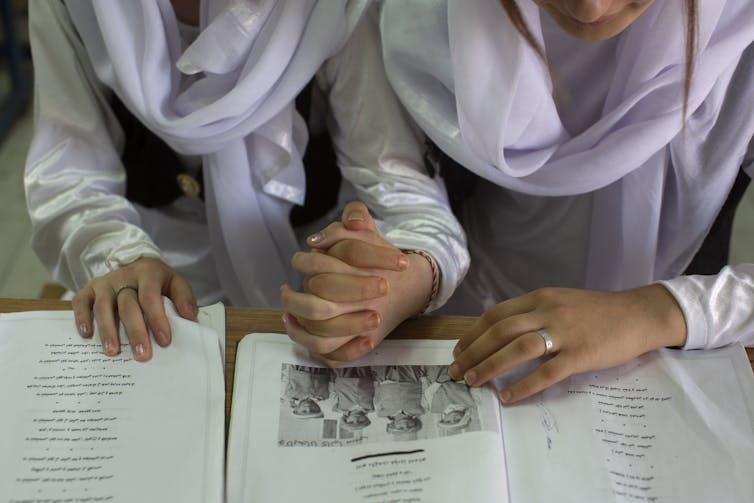The Yezidi genocide devastated Iraq’s community 10 years ago − but the roots of the prejudice that f
Yezidis are an example of what one scholar calls ‘liminal minorities’: faith communities whose religions’ legitimacy is denied by more powerful groups.

On the morning of Aug. 3, 2014, the Islamic State group launched a ruthless and swift campaign in Sinjar, in northwestern Iraq. The target was Yezidis: a monotheistic religious group whose members have long been persecuted.
As forces affiliated with the regional Kurdish government fled in disarray, IS fighters captured and enslaved an estimated 6,800 Yezidis, mostly women and children. About 1,500 Yezidis were executed. A similar number lost their lives from excessive heat, thirst or starvation while stranded on Mount Sinjar, before U.S. airstrikes several days later enabled escape to the relative safety of Kurdish-controlled areas in Syria and Iraq.
The entire Yezidi population of Sinjar, about 250,000 people, lost their homes: around half of all Yezidis across the globe, by my estimate.
Ten years later, it is easy to look back on the massacres as the work of extremist militants. But IS in Iraq recruited heavily among local Sunni Muslims from northwestern Iraq. People who lived alongside Yezidis for many years became their tormentors, rapists, looters and killers.
What explains the ferocity of this genocidal campaign? As a scholar of political violence and Middle East politics, I argue that two main factors led to the anti-Yezidi atrocities.
First, Muslim authorities have historically stigmatized Yezidis and denied their existence as a faith group – one of the focuses of my 2024 book, “Liminal Minorities.” Second, transformations after the U.S. invasion of Iraq fueled resentment, which extremists channeled against this marginalized religious group.

A global pattern
The Yezidi experience reflects a global pattern: a type of marginalization and discrimination against faith groups whom I call “liminal minorities.”
Liminal minorities have two core characteristics. First, they lack theological recognition in the eyes of the area’s dominant religion. In other words, more powerful faith groups do not acknowledge the legitimacy of their religion and denigrate the minority’s beliefs and rituals.
Second, liminal minorities are subjected to widespread stigma transmitted across generations. They are often perceived as a threat to moral order and at times alleged to engage in sexually deviant practices. These patterns of stigmatization beget discrimination.
In addition to Yezidis, liminal minorities include Alevis in Turkey, Baha’is in Iran, and Ahmadis in Indonesia and Pakistan. Religious liminality is not exclusive to the Muslim world: For example, Jehovah’s Witnesses in a variety of countries and Falun Gong in China are also liminal minorities.
Centuries of prejudice
Yezidis’ marginal status is not new. Under the Ottoman Empire, Christian and Jewish communities were offered a limited degree of protection and autonomy in return for paying a special tax – known as the millet system. These groups were recognized as “People of the Book”: monotheists whose religious faith was accepted by Muslim authorities. Yezidis, however, lacked this status.

Even today, Yezidis are often insulted as “devil worshipers.” According to the Yezidi faith, God entrusted the world to his lead angel, Tawûsî Melek, which means “Peacock Angel.” Some Muslim religious authorities, however, conflate this angel with Iblis, the personal name of the devil in Islam.
This misidentification gained widespread acceptance among Muslim clerics by the 16th century. Under Ottoman rulers and Kurdish tribal leaders, the claim was used to justify extreme forms of violence against Yezidis, including mass enslavement and killings.
Political resentment post-Saddam
The stigmatization of Yezidis remained widespread in Iraq throughout the late 20th century. There were no large-scale episodes of religiously motivated massacres targeting Yezidis under the regime of Saddam Hussein. Yet many were forced out of their mountain villages as part of his party’s Arabization campaigns: forced deportations aimed at weakening non-Arab minorities in the country’s north.
Iraq is home to people of both major schools of Islam – Sunni and Shiite – as well as minority faiths such as Yezidis, Christians and Sabaean-Mandaeans, who follow an ancient monotheistic religion. The country is also home to many different ethnic groups, with a large Arab majority and sizable minorities of Kurds, Turkmens and Assyrians.
Sunni Arabs, who make up a minority of the population, formed the backbone of the Saddam regime, while Shiite Arabs and Sunni Kurds were mostly excluded from power. After the U.S. invasion, however, the Shiite majority was able to dominate electoral politics, and many Sunni Arabs complained of being marginalized.
The Kurdish region, meanwhile, consolidated its autonomy. Yezidi votes become crucial to Kurdish claims for additional territory – spurring more Sunni resentment of the Yezidis.

Boiling point
My fieldwork, including extensive interviews between 2017 and 2019, suggests that the Islamic State’s goal of ethnic cleansing capitalized on these feelings of resentment and aimed to undermine Kurdish territorial claims.
Hundreds of Yezidis became victims of violent attacks well before 2014. As the Islamic State group gained power, it further intensified anti-Yezidi stigmas. The group instructed fighters that extreme forms of violence, including systematic rape, were justified by their faith.
The combination of historical hatreds, political resentment and denying the legitimacy of Yezidis’ faith helped spark the violence that devastated Iraq’s Yezidi community in 2014.
Quest for recognition and security
In the wake of the genocide carried out by IS, the Yezidis received unprecedented international attention as a persecuted faith group, and several countries, such as Germany, created resettlement programs for Yezidi refugees. Yezidis in the diaspora became more visible and organized, demanding justice and aiming to mobilize public attention.

Nevertheless, their conditions remain dire. Yezidis are unable to return to Sinjar, which is still an insecure zone contested among rival armed forces. Many remain in camps in Iraqi Kurdistan, facing an uncertain future.
Others have sought refuge abroad, and some benefited from specialized humanitarian asylum programs like Germany’s. The country has been home to part of the Yezidi diaspora since the early 1970s and emerged as a major destination for Yezidis fleeing Iraq after 2014. Today, about 200,000 Yezidis are estimated to live there.
Yet the rise of anti-immigration sentiments in Europe has made the Yezidis’ situation similar to that of many other migrants and refugees. As public attention to the genocide begins to fade, these newcomers face an increasingly inhospitable political climate.
Facing an existential precarity in their homeland and legal limbo in the diaspora, the Yezidi liminality persists.
Güneş Murat Tezcür received funding from the University of Central Florida and the Global Religion Research Initiative based at the University of Notre Dame while conducting research on this topic.
Read These Next
Deception and lies from the White House to justify a war in Venezuela? We’ve seen this movie before
Two US wars based on lies, in which tens of thousands of American troops and millions of civilians died,…
Miami’s new mayor faces a housing affordability crisis, city charter reform and a shrinking budget
Eileen Higgins won a hard-fought election to become Miami’s new mayor. Now for the hard part – governing…
What are gas stove manufacturers trying to hide? Warning labels
The gas industry is opposed to labels that warn consumers of the potential harms of gas stoves.






